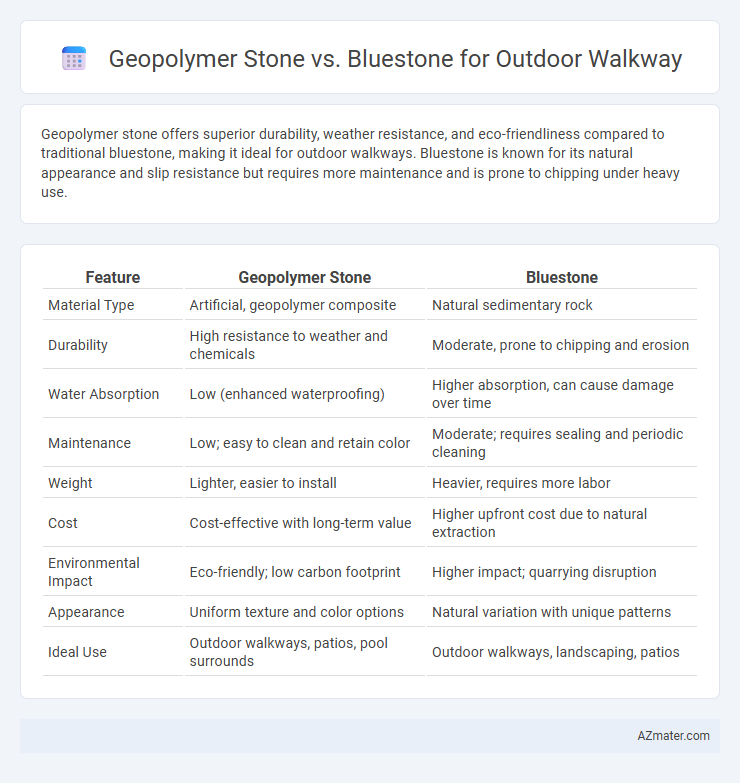Geopolymer stone offers superior durability, weather resistance, and eco-friendliness compared to traditional bluestone, making it ideal for outdoor walkways. Bluestone is known for its natural appearance and slip resistance but requires more maintenance and is prone to chipping under heavy use.
Table of Comparison
| Feature | Geopolymer Stone | Bluestone |
|---|---|---|
| Material Type | Artificial, geopolymer composite | Natural sedimentary rock |
| Durability | High resistance to weather and chemicals | Moderate, prone to chipping and erosion |
| Water Absorption | Low (enhanced waterproofing) | Higher absorption, can cause damage over time |
| Maintenance | Low; easy to clean and retain color | Moderate; requires sealing and periodic cleaning |
| Weight | Lighter, easier to install | Heavier, requires more labor |
| Cost | Cost-effective with long-term value | Higher upfront cost due to natural extraction |
| Environmental Impact | Eco-friendly; low carbon footprint | Higher impact; quarrying disruption |
| Appearance | Uniform texture and color options | Natural variation with unique patterns |
| Ideal Use | Outdoor walkways, patios, pool surrounds | Outdoor walkways, landscaping, patios |
Introduction to Geopolymer Stone and Bluestone
Geopolymer stone, an innovative eco-friendly material, is engineered from industrial byproducts like fly ash and slag, offering high durability and resistance to weathering. Bluestone, a natural sedimentary rock primarily composed of sandstone or limestone, is prized for its rich blue-gray tones and traditional aesthetic appeal in outdoor walkways. Both materials provide strong, slip-resistant surfaces, but geopolymer stone's engineered properties allow for customizable shapes and colors, while bluestone offers authentic natural variation.
Composition and Formation Differences
Geopolymer stone consists of synthetic materials created through the chemical activation of aluminosilicate minerals, resulting in a durable, eco-friendly alternative to natural stone. Bluestone is a natural sedimentary rock primarily composed of sandstone or basalt formed over millions of years through geological processes like sediment deposition and lithification. The key difference lies in geopolymer stone's engineered composition offering consistent strength and resistance, while bluestone's natural formation provides unique textures and color variations ideal for outdoor walkways.
Aesthetic Appeal and Color Variations
Geopolymer stone offers a modern aesthetic appeal with customizable color variations that can mimic natural stone or present vibrant, consistent hues suitable for contemporary outdoor walkways. Bluestone, known for its classic, natural blue-gray tones, provides a timeless and elegant appearance, making it ideal for traditional or rustic designs. While Bluestone's color palette is more limited, its natural veining and texture create a unique visual depth that enhances outdoor spaces.
Durability and Weather Resistance
Geopolymer stone offers superior durability and weather resistance compared to traditional bluestone, making it ideal for outdoor walkways exposed to harsh climates. Its engineered composition resists cracking, erosion, and fading caused by UV rays, moisture, and temperature fluctuations more effectively than natural bluestone, which can be porous and prone to weathering over time. Choosing geopolymer stone ensures a longer-lasting, low-maintenance surface that retains structural integrity and aesthetic appeal in variable weather conditions.
Slip Resistance and Surface Texture
Geopolymer stone offers enhanced slip resistance due to its textured, non-porous surface, making it ideal for wet and slippery outdoor walkways. Bluestone features a natural cleft finish with varied surface textures that provide moderate traction but can become slick when polished or wet. Choosing geopolymer stone ensures consistent slip resistance and durability, while bluestone's natural variations demand more maintenance to maintain safe footing.
Environmental Impact and Sustainability
Geopolymer stone offers a significantly lower carbon footprint than traditional bluestone because it utilizes industrial waste materials and requires less energy during production, reducing greenhouse gas emissions. Bluestone is a natural quarried stone, which involves extensive mining operations that can cause habitat disruption and landscape degradation. The durability and recyclability of geopolymer stone further enhance its sustainability, making it a more eco-friendly option for outdoor walkways compared to bluestone.
Installation Process and Ease of Use
Geopolymer stone offers a lightweight alternative to bluestone, significantly simplifying the installation process by reducing the need for heavy machinery and extensive groundwork. Bluestone requires precise cutting and leveling due to its natural density and weight, making installation labor-intensive and time-consuming. The consistent shape and size of geopolymer stone enhance ease of use, enabling quicker placement and alignment for outdoor walkways.
Cost Comparison and Long-term Value
Geopolymer stone offers a cost-effective alternative to traditional bluestone for outdoor walkways, with installation costs typically 20-30% lower due to easier handling and faster curing times. Bluestone, composed of natural sandstone, tends to have a higher upfront price but provides exceptional durability and aesthetic appeal, often increasing property value over time. While geopolymer stone requires less maintenance and resists weathering, bluestone's proven long-term resilience and natural variation may offer better return on investment for premium outdoor settings.
Maintenance Requirements and Longevity
Geopolymer stone offers superior durability and requires minimal maintenance compared to bluestone, as it resists cracking, chipping, and weather-induced wear more effectively. Bluestone, while aesthetically pleasing, demands regular sealing and cleaning to prevent discoloration and surface erosion from outdoor elements. The longevity of geopolymer stone often exceeds that of bluestone, making it a cost-effective and low-maintenance choice for outdoor walkways exposed to varying climates.
Choosing the Best Material for Your Outdoor Walkway
Geopolymer stone offers superior durability and resistance to weathering compared to bluestone, making it ideal for high-traffic outdoor walkways. Bluestone provides a natural aesthetic with unique color variations but requires more maintenance to prevent wear and staining. When choosing the best material, consider factors like climate resilience, long-term upkeep, and budget to ensure your walkway remains safe and visually appealing.

Infographic: Geopolymer stone vs Bluestone for Outdoor Walkway
 azmater.com
azmater.com